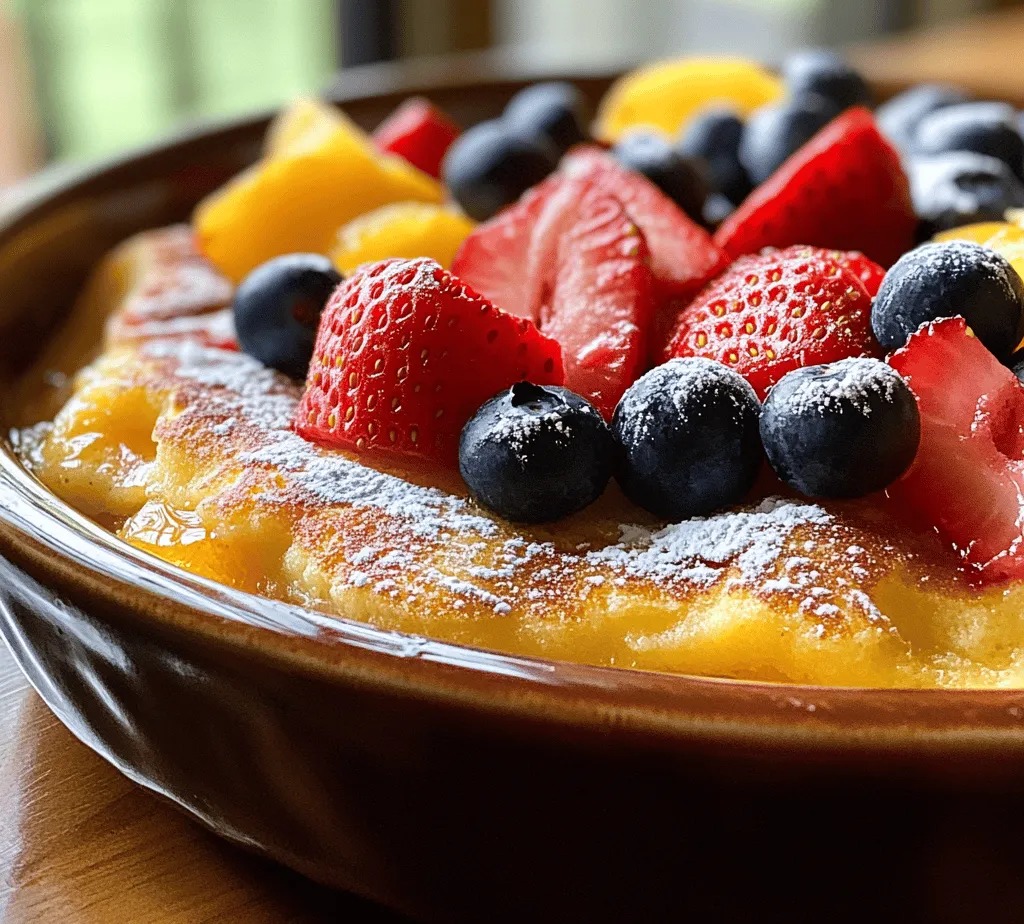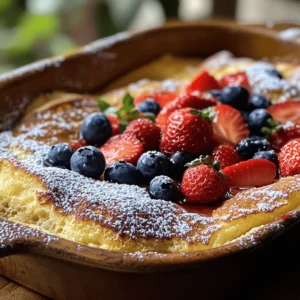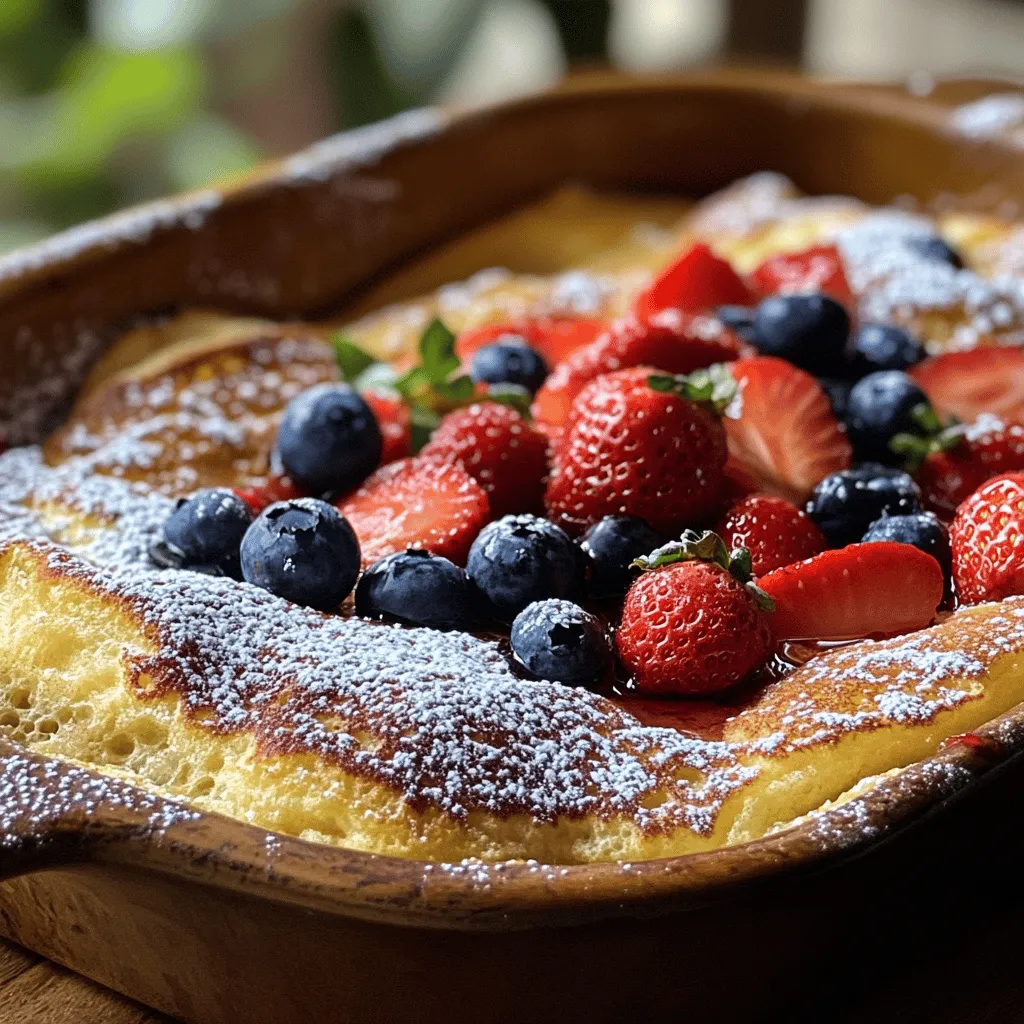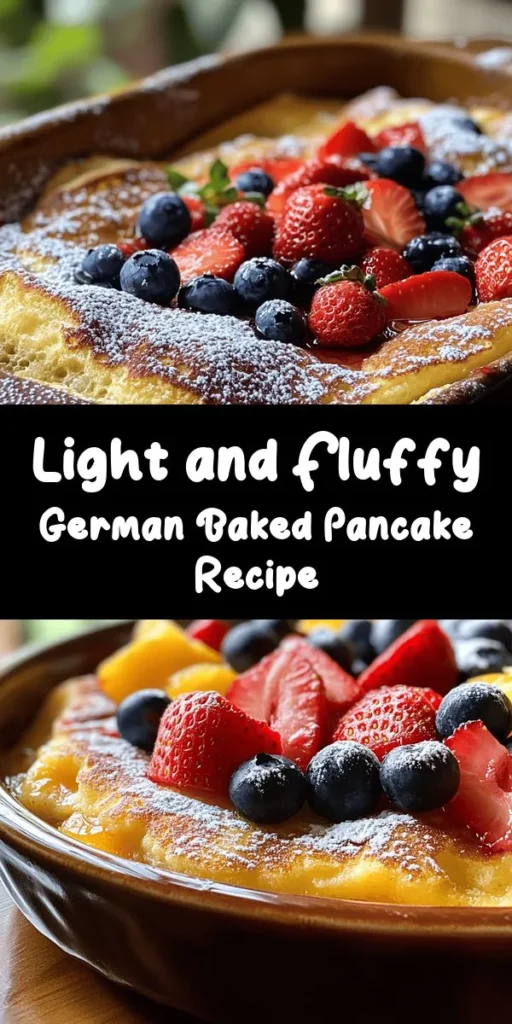Introduction
If you’re on the lookout for a delightful breakfast option that combines simplicity with impressive presentation, look no further than the Fluffy German Pancake. This dish has taken breakfast tables by storm, earning its reputation for being both a treat for the eyes and the palate. Unlike traditional pancakes, which are cooked on a griddle, the German pancake is baked in the oven, resulting in a light, airy texture that puffs up beautifully. Its unique form and flavor profile make it a standout choice for family gatherings or leisurely Sunday brunches.
The popularity of the Baked German Pancake has grown due to its ease of preparation and the joy it brings to family meals. With just a handful of ingredients and minimal effort, you can create a show-stopping dish that delights everyone at the table. Imagine a golden-brown pancake, puffed high with crispy edges and a soft center, waiting to be adorned with your favorite toppings. Whether you prefer a simple dusting of powdered sugar or a lavish drizzle of maple syrup accompanied by fresh fruits, this pancake adapts to your whims perfectly.
Understanding the Baked German Pancake
To fully appreciate the Baked German Pancake, it’s essential to understand its origins and how it differs from other pancake varieties. This dish, also known in Germany as “Dutch Baby,” is believed to have roots tracing back to the early 19th century. It was popularized in the United States by German immigrants, who brought their culinary traditions with them. The pancake is different from standard American pancakes, which are typically smaller, denser, and cooked individually. Instead, the German pancake is a single, large pancake baked in a hot oven, resulting in a fluffier and more ethereal texture.
When comparing the Baked German Pancake to other pancake varieties, the differences become clear. Traditional pancakes are made with baking powder or baking soda, which provides a leavening effect when cooked on a skillet. In contrast, the German pancake relies heavily on eggs for its rise. As the batter bakes, the eggs create steam that lifts the pancake, resulting in its signature puffiness. This unique method not only enhances the texture but also allows for a delightful custard-like center that contrasts beautifully with the crispy edges.
The science behind the fluffiness lies in the combination of ingredients and the baking process. When you whisk eggs into the batter, you incorporate air, which expands during baking. The heat of the oven causes the moisture in the batter to turn into steam, further aiding in the puffing process. The result is a pancake that rises high and forms a delicate, airy structure that can hold toppings without collapsing under the weight.
Essential Ingredients for a Perfect Baked German Pancake
Creating the Fluffy German Pancake requires a few essential ingredients, each playing a crucial role in achieving that perfect texture and flavor. Let’s take a closer look at what you’ll need:
Eggs
The star ingredient in any Baked German Pancake is, without a doubt, the eggs. They provide structure and stability while contributing to the pancake’s fluffiness. Eggs are essential for creating the lift that makes this dish so distinctive. For the best results, use fresh eggs, as they will whip up better, aiding in achieving a light and airy pancake.
Whole Milk
Whole milk is another key player in this recipe. It adds creaminess and richness to the batter, contributing to the overall flavor profile. The fat content in whole milk helps create a tender texture, balancing the eggs and flour. If you’re looking for a lighter version, you can substitute with a lower-fat milk, but keep in mind that this may slightly alter the texture.
All-Purpose Flour
All-purpose flour serves as the base for the pancake. It provides the necessary structure to hold the ingredients together while maintaining a tender crumb. Be sure to measure the flour accurately; too much can lead to a dense pancake, while too little can prevent it from rising properly. Sifting the flour before measuring can help achieve the right consistency and texture.
Granulated Sugar
A touch of granulated sugar enhances the flavor of the pancake and aids in browning the edges, creating a beautiful golden crust. While it adds sweetness, the amount can be adjusted based on personal preference. If you’re topping the pancake with syrup or fruit, you might choose to reduce the sugar slightly.
Vanilla Extract
Adding a splash of vanilla extract elevates the flavor profile of the pancake. It lends a warm, aromatic note that complements the other ingredients perfectly. Opt for pure vanilla extract for the best taste, as imitation vanilla can lack the depth of flavor that enhances this dish.
Salt
While it may seem counterintuitive to add salt to a sweet dish, it plays a crucial role in balancing flavors. A pinch of salt enhances the sweetness of the pancake and brings out the richness of the other ingredients.
Unsalted Butter
Unsalted butter is essential for both flavor and texture. It adds richness to the pancake while helping to create those crispy edges as it melts in the hot oven. Make sure to use unsalted butter to control the overall saltiness of the dish, allowing you to season to taste.
Powdered Sugar
Powdered sugar is often used for serving, adding a touch of sweetness and a beautiful presentation. A light dusting of powdered sugar not only enhances the visual appeal of the pancake but also serves as a lovely counterpoint to the other toppings.
Fresh Fruits
Fruits are a delightful addition to the Baked German Pancake, providing nutritional benefits and adding a burst of freshness. Seasonal fruits such as berries, bananas, or sliced peaches can be used as toppings, allowing you to customize the dish to your liking. They also contribute vibrant colors to the presentation.
Maple Syrup
No pancake is complete without a drizzle of syrup, and maple syrup is the classic accompaniment for the Baked German Pancake. Its rich, sweet flavor complements the fluffiness of the pancake, making each bite a true indulgence. For those who prefer a lighter option, honey or agave syrup can also work well.
Step-by-Step Guide to Making Baked German Pancake
Now that we’ve discussed the essential ingredients, it’s time to dive into the preparation of your Fluffy German Pancake. The process is straightforward, allowing you to whip up this delightful breakfast with minimal fuss.
Preparation Steps
1. Preheat the Oven: Start by preheating your oven to 425°F (220°C). A hot oven is crucial for achieving the perfect puff. As the batter bakes, the heat will cause the eggs to expand rapidly, creating that characteristic rise.
2. Prepare the Baking Dish: While the oven is heating, choose a baking dish or oven-safe skillet. A 9×13-inch baking dish or a cast-iron skillet works beautifully for this recipe. Add a generous amount of unsalted butter to the dish, ensuring it coats the bottom evenly. The butter will melt as the oven heats up, creating a deliciously crispy edge for the pancake.
3. Mix the Batter: In a mixing bowl, whisk together the eggs, whole milk, flour, granulated sugar, vanilla extract, and salt until smooth. It’s important to whisk thoroughly to incorporate air into the batter, which will aid in fluffiness. The batter should be relatively thin but free of lumps.
4. Pour the Batter into the Dish: Once the oven has reached the desired temperature and the butter is melted, carefully remove the baking dish from the oven. Pour the batter into the hot dish over the melted butter. The hot fat creates a sizzling effect, which helps to achieve that coveted puff.
5. Bake: Return the dish to the oven and bake for approximately 20-25 minutes, or until the pancake has risen significantly and the edges are golden brown. Avoid opening the oven door during baking, as this can cause the pancake to deflate.
6. Serve Immediately: Once the pancake is done, remove it from the oven and allow it to cool for a minute. The pancake will start to deflate slightly, which is normal. Dust with powdered sugar and serve topped with fresh fruits and a drizzle of maple syrup for an unforgettable breakfast experience.
With these steps, you’ll be well on your way to creating your very own Fluffy German Pancake. This dish not only serves as a delicious breakfast but also as a wonderful way to bring family and friends together around the table. The combination of simple ingredients and effortless preparation makes it a winning recipe that’s sure to become a favorite in your household.

Preparing the Baking Dish
To achieve a perfectly baked German pancake, it’s essential to prepare your baking dish properly. Start by selecting an oven-safe dish, ideally a cast-iron skillet or a glass baking dish, as these materials distribute heat evenly. The first step is to preheat your oven to 425°F (220°C).
Techniques for Even Butter Distribution:
1. Melt the Butter: Place the butter in your baking dish and put it in the oven while it preheats. This not only melts the butter but also allows it to coat the bottom of the dish evenly.
2. Swirl and Coat: Once melted, carefully remove the dish from the oven, and, using a heatproof brush or spatula, swirl the melted butter around the sides to ensure it coats the entire dish. This helps prevent the pancake from sticking and promotes a beautifully golden edge.
Mixing the Batter
Now that your baking dish is prepared, it’s time to mix the batter. A smooth, well-combined batter is crucial for achieving the desired fluffy texture of your German pancake.
Using a Blender:
1. Combine Ingredients: In a blender, add the eggs, milk, flour, and a pinch of salt. Blend on medium speed until the mixture is smooth and well combined. This method incorporates air into the batter, which is essential for a fluffy finish.
2. Tips for Achieving the Right Consistency: Make sure to scrape down the sides of the blender to ensure all ingredients are fully incorporated. The batter should be somewhat thin but not watery, resembling a pancake batter consistency.
Importance of Frothiness in Batter for Rise:
Whipping air into your batter is key to achieving a light, fluffy pancake. The eggs play a vital role here, as they provide structure and leavening. The more air you incorporate, the more your pancake will rise during baking. Ensure that the batter is blended long enough to be frothy; this will significantly enhance the final texture.
Baking Process
Once your batter is ready and your baking dish is prepped, it’s time to bake!
Timing and Temperature:
1. Perfect Baking Conditions: Pour the batter directly into the hot, buttered skillet. The hot butter will create a sizzling effect, which helps in forming a crisp edge. Bake in the preheated oven for about 20 minutes.
2. Key Factors for Perfect Results: Avoid opening the oven door during baking, as the sudden drop in temperature can cause the pancake to deflate.
Observing Changes:
As the pancake bakes, you will notice it rising and puffing up dramatically. This is perfectly normal and expected. The edges will begin to turn golden brown, while the center will maintain a slightly soft texture. Keep an eye on it to ensure it doesn’t overcook, as the pancake will continue to cook slightly after being removed from the oven.
Serving Suggestions
The German pancake is not just a visual delight; it can be enjoyed in a variety of ways.
How to Dust with Powdered Sugar for Aesthetic Appeal:
Once out of the oven, allow your pancake to cool for just a minute before serving. Use a fine mesh sieve to dust powdered sugar evenly across the top. This adds a lovely touch and enhances the visual appeal.
Creative Ideas for Toppings:
1. Fresh Fruits: Serve with seasonal fruits such as berries, sliced bananas, or peaches. This adds not only flavor but also a burst of color.
2. Syrups and Sauces: Drizzle with maple syrup, honey, or a fruit compote for added sweetness. Experiment with flavored syrups such as blueberry or strawberry for a twist.
Nutritional Information
Understanding the nutritional profile of your Fluffy German Pancake can help you make informed choices.
Breakdown of Calories and Macronutrients per Serving:
– Calories: Approximately 200 calories per serving
– Protein: 7 grams
– Carbohydrates: 25 grams
– Fat: 8 grams
This calculation may vary slightly based on the specific quantities and brands of ingredients used.
Health Benefits of the Ingredients Used:
1. Eggs as a Source of Protein: Eggs are a fantastic source of high-quality protein, which is essential for muscle repair and growth, making this pancake a hearty breakfast option.
2. Fruits for Vitamins and Fiber: Adding fresh fruits not only enhances the flavor but also boosts the vitamin content and adds dietary fiber, promoting digestive health.
3. Consideration of Sugar Content and Alternatives: While the pancake itself has moderate sugar content, you can control the sweetness by adjusting the amount of powdered sugar on top or opting for natural sweeteners like agave syrup or honey.
Variations and Customizations
One of the best aspects of the Fluffy German Pancake is its versatility. Here are some ideas to customize your dish further.
Flavor Variations:
1. Incorporating Spices or Extracts: Elevate the flavor by adding a teaspoon of vanilla extract or a sprinkle of cinnamon to the batter. Nutmeg is another delightful spice that complements the sweet flavors perfectly.
Dietary Adaptations:
1. Gluten-Free Options: Substitute all-purpose flour with a gluten-free flour blend. Almond flour or coconut flour can also be used, but you may need to adjust the liquid proportions to achieve the correct batter consistency.
Seasonal Adaptations:
1. Utilizing Seasonal Fruits: Customize your toppings based on what’s in season. In fall, consider using caramelized apples or pears, while in summer, fresh cherries or a mix of tropical fruits can be delightful.
Conclusion
The Fluffy German Pancake is a simple yet impressive dish that can elevate your breakfast game. Its light, airy texture and the ability to customize toppings make it suitable for various occasions – whether it’s a leisurely brunch with friends or a quick family breakfast on a busy morning.
The versatility of this recipe is unmatched; it can easily transition into a dessert with the right toppings. I encourage you to try this recipe and experience the delightful taste of this German classic firsthand. Enjoy the process, and relish in the joy of sharing your creation with family and friends!



